Project Subtitle:
Project Description:
Our home is a newly constructed single-family residence located in downtown Maynard, Massachusetts. Maynard is a micro urban community west of Boston full of sidewalks, stores, and eateries. We reside in the house with our two children.
As potential first-time homebuyers we had initially searched Maynard for an existing starter home that would provide 1) comfort 2) healthy indoor air quality 3) walkability enabling us to function as a one-car family and 4) outdoor space for our children to play. But what we found left us uninspired. We envisioned living in a passive solar home that was efficient, sunny, and contemporary and wondered: is it possible for a family on a small budget to build such a home onsite using conventional methods and materials?
Initially we had doubts, and almost abandoned the idea. But visiting the three winning entries of the Massachusetts 2009 Zero Energy Challenge encouraged us. We committed to the project when we found a rare 1/4 acre lot in Maynard perfect for our needs. To stay within budget we kept the footprint small at 1248 sq ft and the house was designed with multi-functional spaces on a single floor. The result of the integrated design team approach is a solar energy home that is beautiful and comfortable and which reflects our values and our aesthetics, while more traditional choices for exterior materials and details allow the house to fit into our New England neighborhood. And with ample attic storage and no need for a furnace we gratefully omitted the New England basement. The design also reflects the idea that 'home' is the outdoors, too. We included three exterior doors for easy access to the patio, yard and garden. The great room with its vaulted ceiling is filled with natural sunlight such that we rarely need electric lighting before sundown.
The passive solar space heating, solar hot water system, and the superinsulated envelope result in very low energy use, while the solar PV array produces more energy than what is used on site. What makes our house unique is that we are net-zero energy not just on a year-to-year basis, but every month since the PV and solar hot water systems went online we have produced as much or more than we consumed—even in the coldest and cloudiest months and without sacrifice to comfort or convenience. Our 4,000 kWh yearly surplus would cover the energy needed for daily driving with the electric car we hope to someday acquire. Other sustainable features include Energy Star appliances, WaterSense fixtures, and a rain water collection system for gardening.
One unexpected result from building in a downtown location is the community response. From passers-by and groups of students to NESEA open house participants, our community wants to learn from what we have done. Our message is simple: sustainable, comfortable, and attractive net-zero homes are now within reach of moderate income families. We will continue to send this message as we enjoy our home for years to come.
Building Type Summary:
Address:
Elevation:
Lat. / Long.:
Location Type:
Köppen Climate Type:
Climate Region:
Solar Insolation:
Occupancy Type and Details:
The house is used as the only residence for our family of four, which includes two children. One grandparent has lived with us for the entire duration of a two-month visit. During the last 12 months we had 5 days of vacation with the entire family away from home.
Days of occupancy: 360
Person days of occupancy: 1500 (360 x 4 + 60)
Conditioned Floor Area:
Multiple buildings?:
Historic?:
HERS Index:
Annual renewable energy generated:
Subslab assembly:
6” total thickness rigid XPS (3 layers of 2” thick boards), entire area, R-30
Slab edge assembly:
overall R30, but complex detail:
4” total thickness rigid XPS (3 layers of 2” thick boards), R-20.
6” thick section of concrete foundation wall above grade
2” thick rigid XPS exterior insulation with protective coating (Tuff II Coating, Styro Industries), R-10
Foundation wall assembly:
2” thick rigid XPS exterior insulation (R-10) below and above grade, entire depth of foundation wall to the top of foundation footing (4 ft). No basement.
Above grade wall assembly:
Double stud wall, 12” wall cavity, dense pack cellulose (GreenFiber Cocoon2), R-43
Cedar board siding (1”) with vented rain-screen (3/8”).
Flat attic assembly:
24” depth loose fill cellulose (GreenFiber Cocoon2), R-80. Cold attic (vented)
Cathedral ceiling assembly:
24” depth loose fill cellulose (GreenFiber Cocoon2), R-80. Cold attic (vented)
Space heating - Manufacturer & Model:
Space cooling - Manufacturer & Model:
Domestic hot water - Manufacturer & Model:
Ventilation - Manufacturer & Model:
Finances Description:
Building construction: $243,000. This is the project total with the general contractor, and it includes site-work, such as excavation for foundation and utility connections, fees for connection to utilities ($5000 for town water and sewer), landscaping ($5,000), solar PV system ($36,900), solar hot water system ($8,000). The rebates and incentives are not accounted for in this total cost.
Total Cost of Project:
Energy Strategies:
The house integrates three solar energy systems: passive solar space heating, solar domestic hot water, and a solar photovoltaic system.
Passive solar space heating: direct solar heat gain through high SHGC south-facing windows, with the finished 4.5” thick concrete floor providing the thermal mass for thermal collection and storage. Concrete slab is passive with no additional radiant heat source, and to assure thermal comfort for occupants it has been designed as a thermal island, with R-30 under slab and R-30 overall slab edge insulation and additional below grade R-10 exterior foundation wall insulation.
Solar domestic hot water: Two SunEarth EC-32 (4'x8') flat panel collectors, (SunEarth rebranded) Rheem Solaraide HE 80G tank with heat exchanger and electric element backup (240V, 4500 W).
Energy Use and Production Documentation:
Subslab R-value:
Slab edge R-value:
Foundation wall R-value:
Above grade wall R-value:
Flat attic R-value:
Cathedral ceiling R-value:
Average window U-factor:
Solar Heat Gain Coefficient:
Cost per square foot of Conditioned Space:
Project Photos:
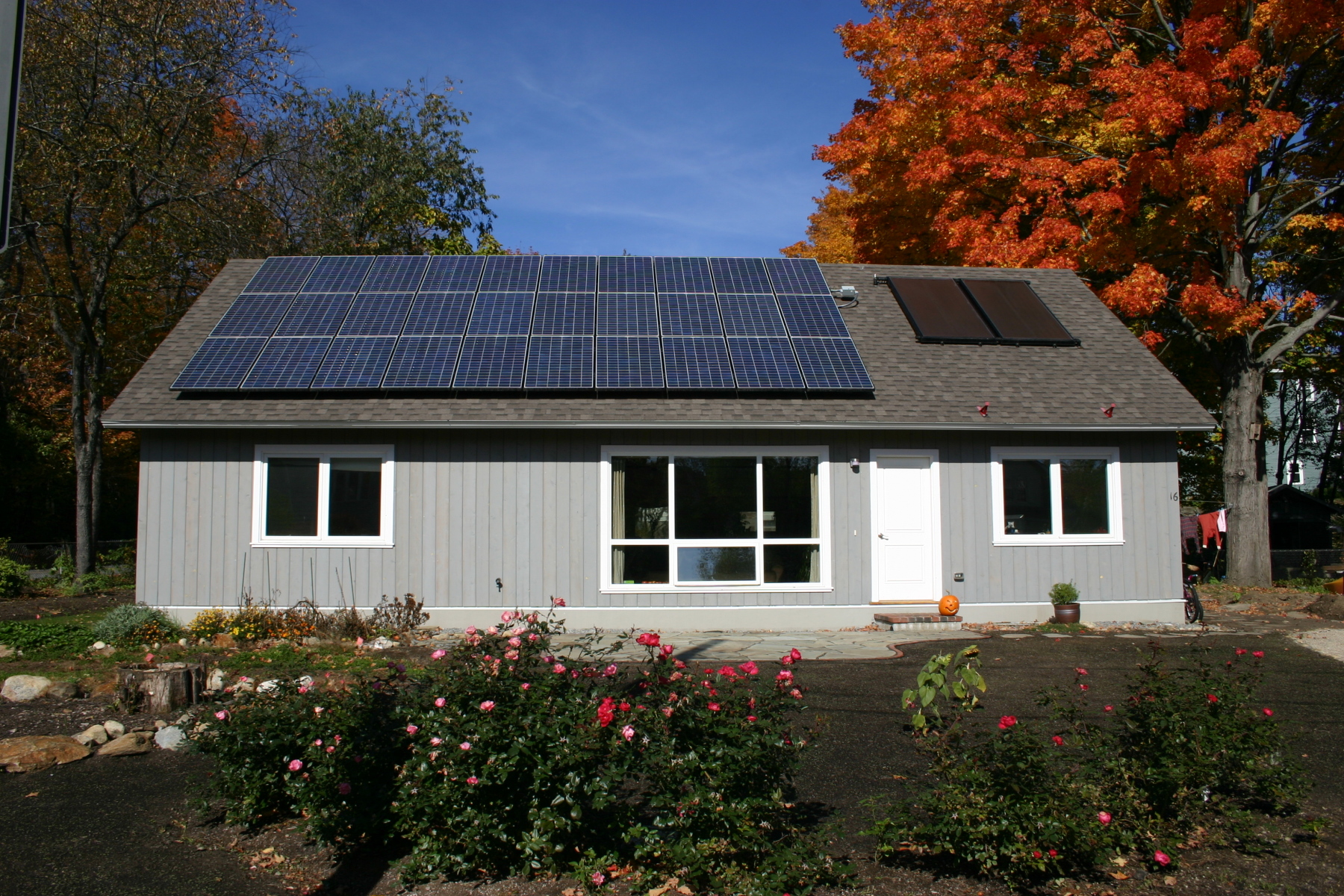
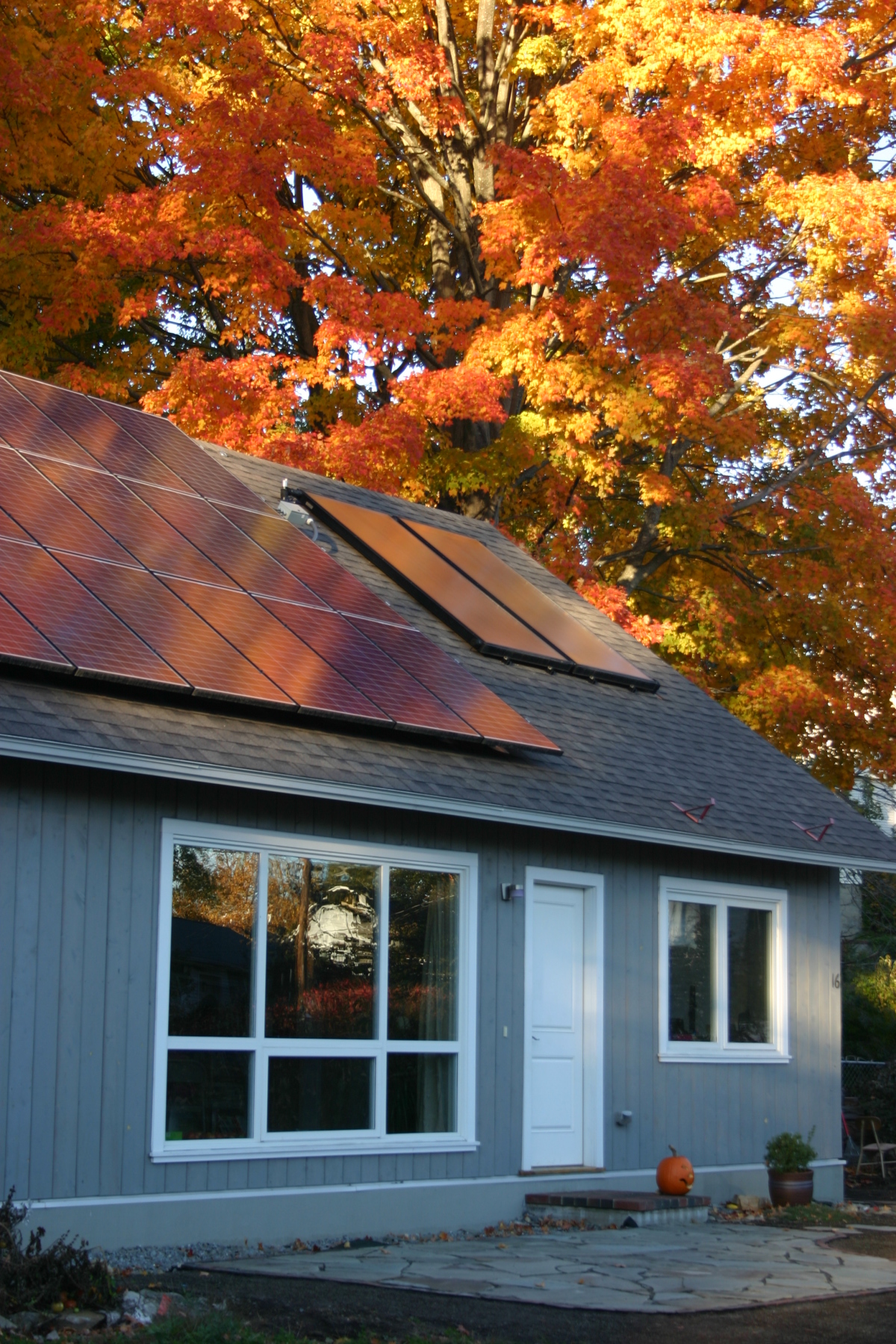
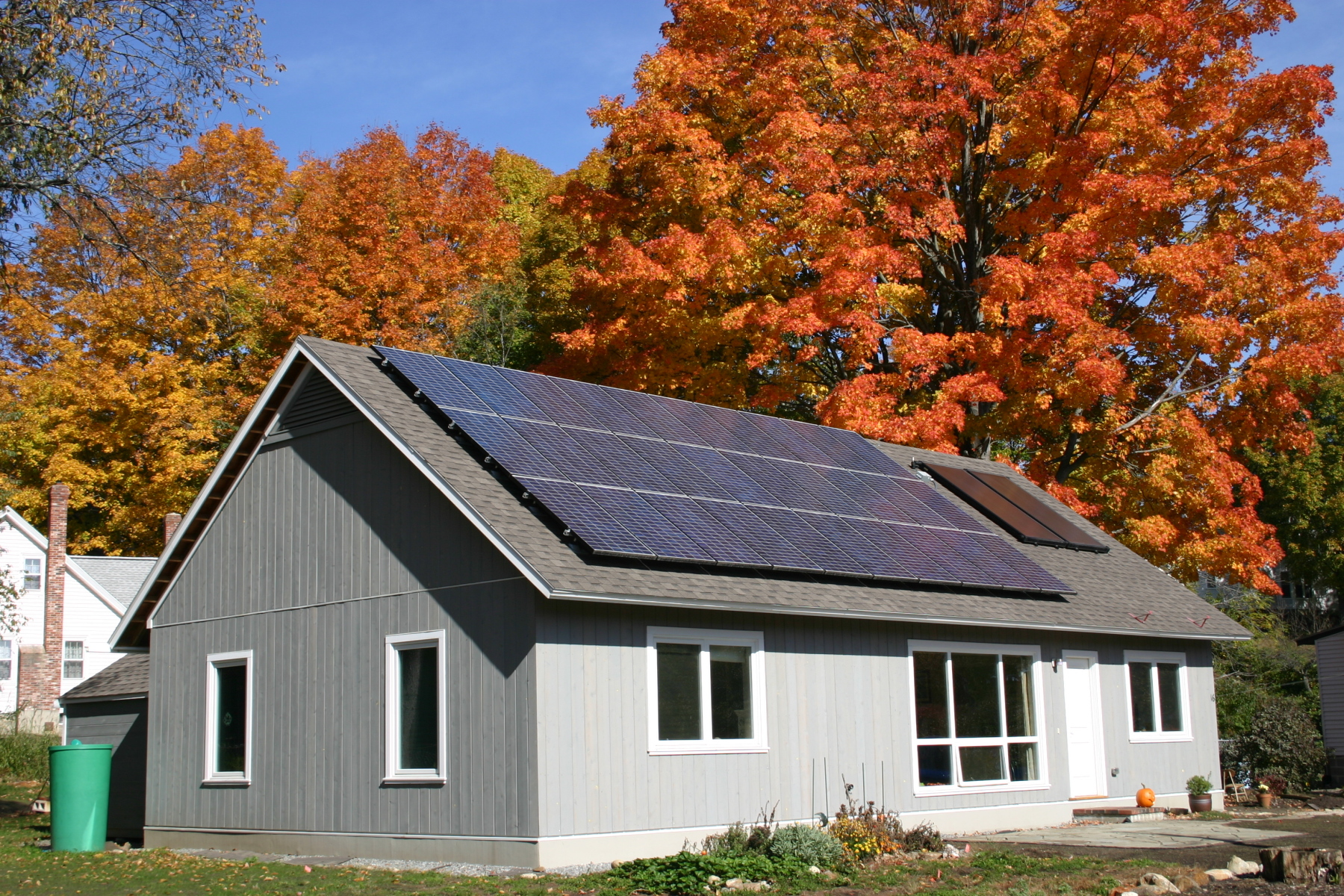
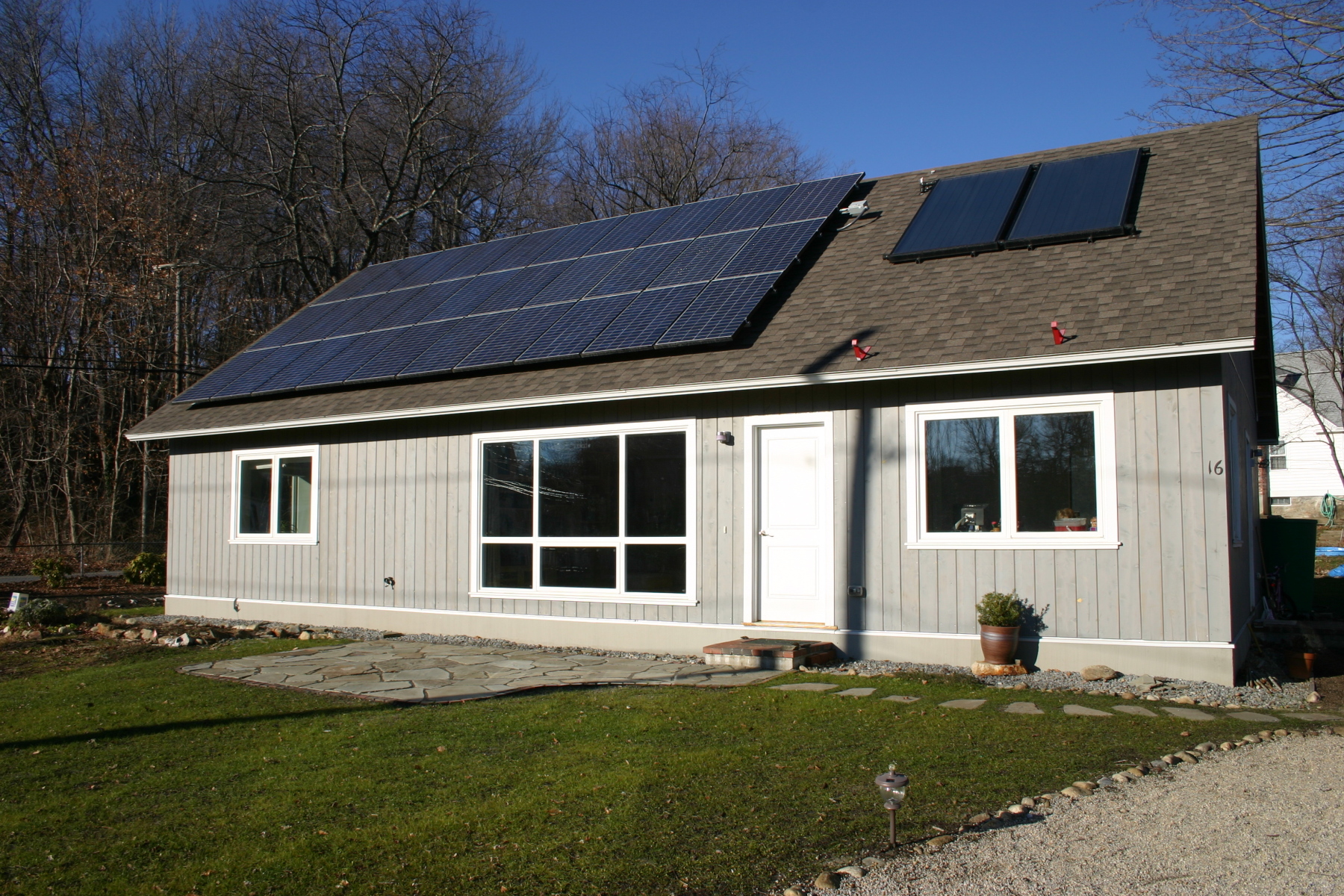
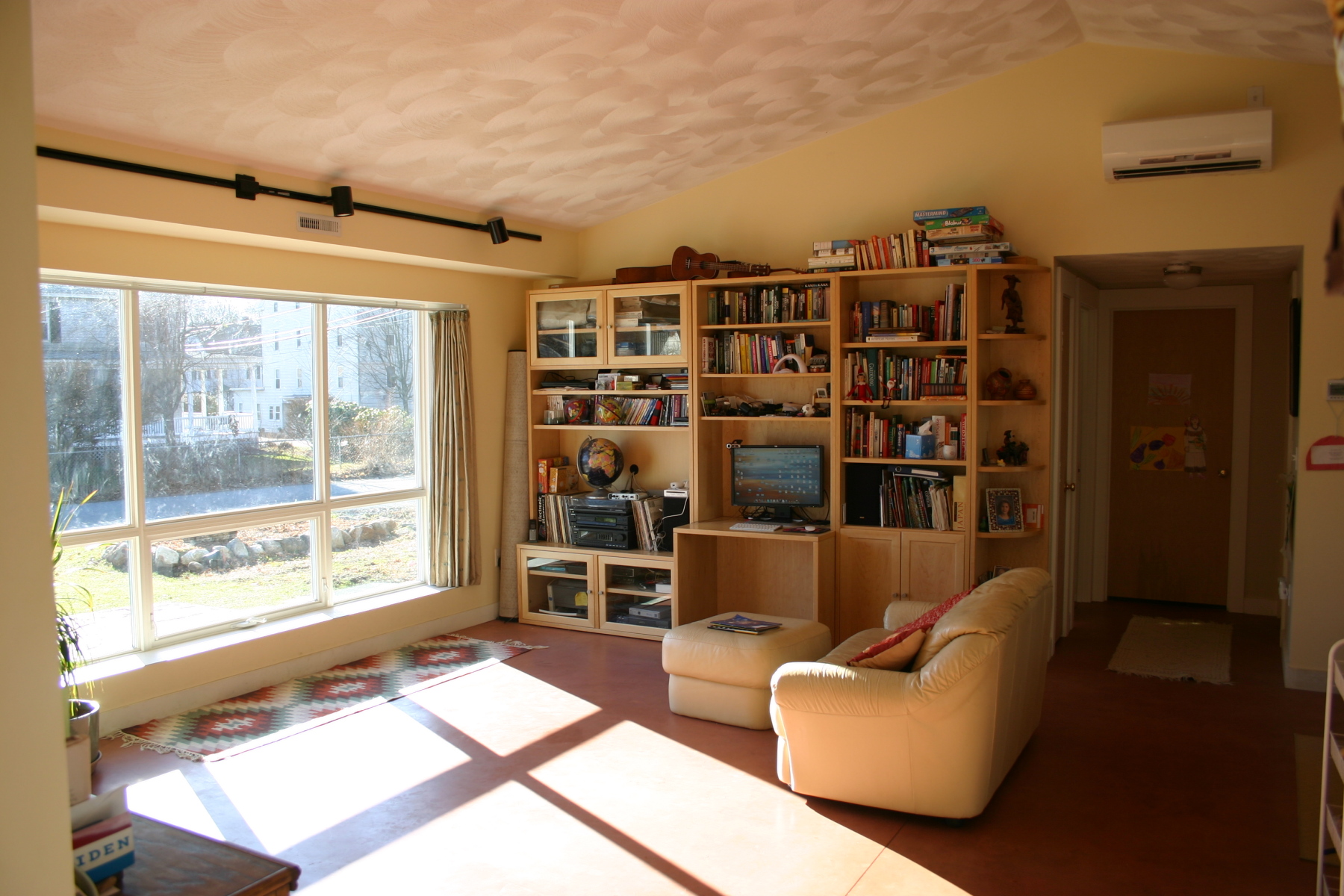
Renewable Energy Sources:
Window Description:
Because window configuration is optimized for passive solar space heating, they have different solar heat gain coefficient (SHGC) and U-values, based on their orientation: high SHGC on the South side, low SHGC on all other sides. Of the total 155.6 sf glazing area, 66% is on the South side, 9% on the North side, and 25% on the East and West sides.
All windows are Inline Fiberglass, Series 325, triple-pane argon filled. Listed SHGC and U-values are full frame.
